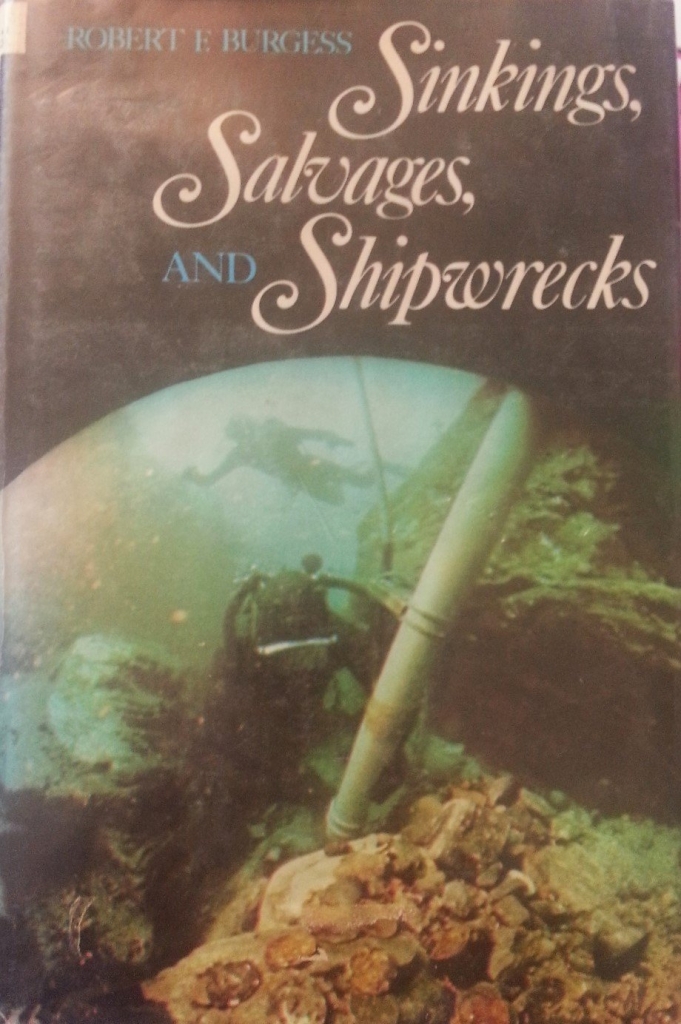 The ReviewRobert Burgess' book "Sinking, Salvages, and Shipwrecks" (note the beloved Oxford comma in this title) took me back to the days when the world still seemed large and full of unexplored regions. Where forgotten pirate treasures litter the reefs or can be found underneath the third palm tree East of the lion's head-shaped stone.Where sailing across the Atlantic was a step into a world of adventure and unknown risk. Fast forward to today and the person planning to undertake a transatlantic crossing by sailing boat can buy themselves into a berth on a suitable 25m yacht at under $4,500 - complete with frequent Instagram posts while sailing and a post-trip documentary of the whole "arduous adventure".Not so in the world of Mr. Burgess! Here be sea dragons, the onset of sudden adverse weather conditions, mountainous seas, and treacherous uncharted rocky peaks jutting out of the surf surrounding otherwise friendly shorelines.Here also are hardy treasure hunters who spend years of their life beachcombing remote shores with metal detectors and hunting for clues in old stories, handed-down shanties, and scraps of maps and gazetteers. Mr. Burgess was actually one of those while still a boy, improvising some diving gear to take a look at a wreck under 10m of water in a spring-fed lake near Lake Michigan (and I quote):"Since this was before the days of swim fins, face masks, and scuba gear, we decided to have a look at the wreck with homemade diving equipment. It consisted of an ancient fly-wheel air pump connected by fifty feet of air hose to a World War II gas mask with its canister removed.A dozen extension cords allowed us to plug the pump's electric motor into the outlet at a nearby cottage on the cold September day we elected to have our first trial run. The test was a success. I had clutched at the weeds on the bottom of the lake to hold myself five feet under water for fifteen minutes. All we had to do was replace the electric motor with a gasoline engine and we would be ready to dive on the Griffin the next summer."This was the author at age 15 or so, proving that adventure endures as long as kids will be allowed to play outside without supervision.Mr. Burgess starts his book describing how in 1628 the most splendid warship Vasa, crown jewel of the Swedish fleet, scuttled on her first journey out of the harbour. To make a good show for the festive crowds gathered to see this marvel of modern shipbuilding set off to the Thirty Year's War, the Vasa unfurled her sails with her two rows of cannon ports open on both sides of the vessel with all 64 bronze cannon proudly drawn outward to deliver two broadside salutes as she would sail off.Less than a mile from shore, a sudden gust of wind heeled the ship sharply to port, and instead of righting herself, the Vasa listed and settled down ever lower in the water. As the ship heeled, the lower portside gun ports has scooped in so much water as could not be removed in time and the proud ship sunk like stone before the startled eyes of the crowds on the quay. The ship was eventually salvaged nearly intact in 1958 and stands in a Stockholm museum as one of the best-preserved fighting galleons of that bygone era.The book is full of stories like these, I especially enjoyed the parts where the author discussed the Spanish treasure fleets of the 1700s, their various sinkings on account of adverse weather conditions, inhospitable shorelines, and a touch of piracy; and their subsequent salvaging, both historical and contemporary. These parts of the book were among the most well-narrated and show the intense personal interest of Mr. Burgess. He narrates with relish the exploits of the "Real Eight" salvaging company, that recovered well over USD 10 million (in today's money) in Spanish silver and gold coin on the Florida Coast.Even one of the nephews of the company's owner got into the action as he found a beautiful golden necklace with sea dragon pendant (that doubled as a whistle, toothpick, and ear wax remover) lying quite exposed above the high-water line. The necklace was later identified as belonging to the Admiral of that particular treasure transport who had gone down with his flagship in the storm that doomed his fleet in 1715.So grab a bottle of rum out of the sea chest and settle down for a good evening's worth of stories of the high seas, ya landlubbers!*Read more reviews by Sjors here
The ReviewRobert Burgess' book "Sinking, Salvages, and Shipwrecks" (note the beloved Oxford comma in this title) took me back to the days when the world still seemed large and full of unexplored regions. Where forgotten pirate treasures litter the reefs or can be found underneath the third palm tree East of the lion's head-shaped stone.Where sailing across the Atlantic was a step into a world of adventure and unknown risk. Fast forward to today and the person planning to undertake a transatlantic crossing by sailing boat can buy themselves into a berth on a suitable 25m yacht at under $4,500 - complete with frequent Instagram posts while sailing and a post-trip documentary of the whole "arduous adventure".Not so in the world of Mr. Burgess! Here be sea dragons, the onset of sudden adverse weather conditions, mountainous seas, and treacherous uncharted rocky peaks jutting out of the surf surrounding otherwise friendly shorelines.Here also are hardy treasure hunters who spend years of their life beachcombing remote shores with metal detectors and hunting for clues in old stories, handed-down shanties, and scraps of maps and gazetteers. Mr. Burgess was actually one of those while still a boy, improvising some diving gear to take a look at a wreck under 10m of water in a spring-fed lake near Lake Michigan (and I quote):"Since this was before the days of swim fins, face masks, and scuba gear, we decided to have a look at the wreck with homemade diving equipment. It consisted of an ancient fly-wheel air pump connected by fifty feet of air hose to a World War II gas mask with its canister removed.A dozen extension cords allowed us to plug the pump's electric motor into the outlet at a nearby cottage on the cold September day we elected to have our first trial run. The test was a success. I had clutched at the weeds on the bottom of the lake to hold myself five feet under water for fifteen minutes. All we had to do was replace the electric motor with a gasoline engine and we would be ready to dive on the Griffin the next summer."This was the author at age 15 or so, proving that adventure endures as long as kids will be allowed to play outside without supervision.Mr. Burgess starts his book describing how in 1628 the most splendid warship Vasa, crown jewel of the Swedish fleet, scuttled on her first journey out of the harbour. To make a good show for the festive crowds gathered to see this marvel of modern shipbuilding set off to the Thirty Year's War, the Vasa unfurled her sails with her two rows of cannon ports open on both sides of the vessel with all 64 bronze cannon proudly drawn outward to deliver two broadside salutes as she would sail off.Less than a mile from shore, a sudden gust of wind heeled the ship sharply to port, and instead of righting herself, the Vasa listed and settled down ever lower in the water. As the ship heeled, the lower portside gun ports has scooped in so much water as could not be removed in time and the proud ship sunk like stone before the startled eyes of the crowds on the quay. The ship was eventually salvaged nearly intact in 1958 and stands in a Stockholm museum as one of the best-preserved fighting galleons of that bygone era.The book is full of stories like these, I especially enjoyed the parts where the author discussed the Spanish treasure fleets of the 1700s, their various sinkings on account of adverse weather conditions, inhospitable shorelines, and a touch of piracy; and their subsequent salvaging, both historical and contemporary. These parts of the book were among the most well-narrated and show the intense personal interest of Mr. Burgess. He narrates with relish the exploits of the "Real Eight" salvaging company, that recovered well over USD 10 million (in today's money) in Spanish silver and gold coin on the Florida Coast.Even one of the nephews of the company's owner got into the action as he found a beautiful golden necklace with sea dragon pendant (that doubled as a whistle, toothpick, and ear wax remover) lying quite exposed above the high-water line. The necklace was later identified as belonging to the Admiral of that particular treasure transport who had gone down with his flagship in the storm that doomed his fleet in 1715.So grab a bottle of rum out of the sea chest and settle down for a good evening's worth of stories of the high seas, ya landlubbers!*Read more reviews by Sjors hereBook Review: Sinkings, Salvages, and Shipwrecks By Robert Burgess
19th Dec, 2019 at 11:00AM
The Run Down:Throughout marine history certain marine disasters, salvage efforts, or shipwrecks have stood out above all the others. This book by Robert F. Burgess and its rare photographs tell you why they were unusual. The ReviewRobert Burgess' book "Sinking, Salvages, and Shipwrecks" (note the beloved Oxford comma in this title) took me back to the days when the world still seemed large and full of unexplored regions. Where forgotten pirate treasures litter the reefs or can be found underneath the third palm tree East of the lion's head-shaped stone.Where sailing across the Atlantic was a step into a world of adventure and unknown risk. Fast forward to today and the person planning to undertake a transatlantic crossing by sailing boat can buy themselves into a berth on a suitable 25m yacht at under $4,500 - complete with frequent Instagram posts while sailing and a post-trip documentary of the whole "arduous adventure".Not so in the world of Mr. Burgess! Here be sea dragons, the onset of sudden adverse weather conditions, mountainous seas, and treacherous uncharted rocky peaks jutting out of the surf surrounding otherwise friendly shorelines.Here also are hardy treasure hunters who spend years of their life beachcombing remote shores with metal detectors and hunting for clues in old stories, handed-down shanties, and scraps of maps and gazetteers. Mr. Burgess was actually one of those while still a boy, improvising some diving gear to take a look at a wreck under 10m of water in a spring-fed lake near Lake Michigan (and I quote):"Since this was before the days of swim fins, face masks, and scuba gear, we decided to have a look at the wreck with homemade diving equipment. It consisted of an ancient fly-wheel air pump connected by fifty feet of air hose to a World War II gas mask with its canister removed.A dozen extension cords allowed us to plug the pump's electric motor into the outlet at a nearby cottage on the cold September day we elected to have our first trial run. The test was a success. I had clutched at the weeds on the bottom of the lake to hold myself five feet under water for fifteen minutes. All we had to do was replace the electric motor with a gasoline engine and we would be ready to dive on the Griffin the next summer."This was the author at age 15 or so, proving that adventure endures as long as kids will be allowed to play outside without supervision.Mr. Burgess starts his book describing how in 1628 the most splendid warship Vasa, crown jewel of the Swedish fleet, scuttled on her first journey out of the harbour. To make a good show for the festive crowds gathered to see this marvel of modern shipbuilding set off to the Thirty Year's War, the Vasa unfurled her sails with her two rows of cannon ports open on both sides of the vessel with all 64 bronze cannon proudly drawn outward to deliver two broadside salutes as she would sail off.Less than a mile from shore, a sudden gust of wind heeled the ship sharply to port, and instead of righting herself, the Vasa listed and settled down ever lower in the water. As the ship heeled, the lower portside gun ports has scooped in so much water as could not be removed in time and the proud ship sunk like stone before the startled eyes of the crowds on the quay. The ship was eventually salvaged nearly intact in 1958 and stands in a Stockholm museum as one of the best-preserved fighting galleons of that bygone era.The book is full of stories like these, I especially enjoyed the parts where the author discussed the Spanish treasure fleets of the 1700s, their various sinkings on account of adverse weather conditions, inhospitable shorelines, and a touch of piracy; and their subsequent salvaging, both historical and contemporary. These parts of the book were among the most well-narrated and show the intense personal interest of Mr. Burgess. He narrates with relish the exploits of the "Real Eight" salvaging company, that recovered well over USD 10 million (in today's money) in Spanish silver and gold coin on the Florida Coast.Even one of the nephews of the company's owner got into the action as he found a beautiful golden necklace with sea dragon pendant (that doubled as a whistle, toothpick, and ear wax remover) lying quite exposed above the high-water line. The necklace was later identified as belonging to the Admiral of that particular treasure transport who had gone down with his flagship in the storm that doomed his fleet in 1715.So grab a bottle of rum out of the sea chest and settle down for a good evening's worth of stories of the high seas, ya landlubbers!*Read more reviews by Sjors here
The ReviewRobert Burgess' book "Sinking, Salvages, and Shipwrecks" (note the beloved Oxford comma in this title) took me back to the days when the world still seemed large and full of unexplored regions. Where forgotten pirate treasures litter the reefs or can be found underneath the third palm tree East of the lion's head-shaped stone.Where sailing across the Atlantic was a step into a world of adventure and unknown risk. Fast forward to today and the person planning to undertake a transatlantic crossing by sailing boat can buy themselves into a berth on a suitable 25m yacht at under $4,500 - complete with frequent Instagram posts while sailing and a post-trip documentary of the whole "arduous adventure".Not so in the world of Mr. Burgess! Here be sea dragons, the onset of sudden adverse weather conditions, mountainous seas, and treacherous uncharted rocky peaks jutting out of the surf surrounding otherwise friendly shorelines.Here also are hardy treasure hunters who spend years of their life beachcombing remote shores with metal detectors and hunting for clues in old stories, handed-down shanties, and scraps of maps and gazetteers. Mr. Burgess was actually one of those while still a boy, improvising some diving gear to take a look at a wreck under 10m of water in a spring-fed lake near Lake Michigan (and I quote):"Since this was before the days of swim fins, face masks, and scuba gear, we decided to have a look at the wreck with homemade diving equipment. It consisted of an ancient fly-wheel air pump connected by fifty feet of air hose to a World War II gas mask with its canister removed.A dozen extension cords allowed us to plug the pump's electric motor into the outlet at a nearby cottage on the cold September day we elected to have our first trial run. The test was a success. I had clutched at the weeds on the bottom of the lake to hold myself five feet under water for fifteen minutes. All we had to do was replace the electric motor with a gasoline engine and we would be ready to dive on the Griffin the next summer."This was the author at age 15 or so, proving that adventure endures as long as kids will be allowed to play outside without supervision.Mr. Burgess starts his book describing how in 1628 the most splendid warship Vasa, crown jewel of the Swedish fleet, scuttled on her first journey out of the harbour. To make a good show for the festive crowds gathered to see this marvel of modern shipbuilding set off to the Thirty Year's War, the Vasa unfurled her sails with her two rows of cannon ports open on both sides of the vessel with all 64 bronze cannon proudly drawn outward to deliver two broadside salutes as she would sail off.Less than a mile from shore, a sudden gust of wind heeled the ship sharply to port, and instead of righting herself, the Vasa listed and settled down ever lower in the water. As the ship heeled, the lower portside gun ports has scooped in so much water as could not be removed in time and the proud ship sunk like stone before the startled eyes of the crowds on the quay. The ship was eventually salvaged nearly intact in 1958 and stands in a Stockholm museum as one of the best-preserved fighting galleons of that bygone era.The book is full of stories like these, I especially enjoyed the parts where the author discussed the Spanish treasure fleets of the 1700s, their various sinkings on account of adverse weather conditions, inhospitable shorelines, and a touch of piracy; and their subsequent salvaging, both historical and contemporary. These parts of the book were among the most well-narrated and show the intense personal interest of Mr. Burgess. He narrates with relish the exploits of the "Real Eight" salvaging company, that recovered well over USD 10 million (in today's money) in Spanish silver and gold coin on the Florida Coast.Even one of the nephews of the company's owner got into the action as he found a beautiful golden necklace with sea dragon pendant (that doubled as a whistle, toothpick, and ear wax remover) lying quite exposed above the high-water line. The necklace was later identified as belonging to the Admiral of that particular treasure transport who had gone down with his flagship in the storm that doomed his fleet in 1715.So grab a bottle of rum out of the sea chest and settle down for a good evening's worth of stories of the high seas, ya landlubbers!*Read more reviews by Sjors here
 The ReviewRobert Burgess' book "Sinking, Salvages, and Shipwrecks" (note the beloved Oxford comma in this title) took me back to the days when the world still seemed large and full of unexplored regions. Where forgotten pirate treasures litter the reefs or can be found underneath the third palm tree East of the lion's head-shaped stone.Where sailing across the Atlantic was a step into a world of adventure and unknown risk. Fast forward to today and the person planning to undertake a transatlantic crossing by sailing boat can buy themselves into a berth on a suitable 25m yacht at under $4,500 - complete with frequent Instagram posts while sailing and a post-trip documentary of the whole "arduous adventure".Not so in the world of Mr. Burgess! Here be sea dragons, the onset of sudden adverse weather conditions, mountainous seas, and treacherous uncharted rocky peaks jutting out of the surf surrounding otherwise friendly shorelines.Here also are hardy treasure hunters who spend years of their life beachcombing remote shores with metal detectors and hunting for clues in old stories, handed-down shanties, and scraps of maps and gazetteers. Mr. Burgess was actually one of those while still a boy, improvising some diving gear to take a look at a wreck under 10m of water in a spring-fed lake near Lake Michigan (and I quote):"Since this was before the days of swim fins, face masks, and scuba gear, we decided to have a look at the wreck with homemade diving equipment. It consisted of an ancient fly-wheel air pump connected by fifty feet of air hose to a World War II gas mask with its canister removed.A dozen extension cords allowed us to plug the pump's electric motor into the outlet at a nearby cottage on the cold September day we elected to have our first trial run. The test was a success. I had clutched at the weeds on the bottom of the lake to hold myself five feet under water for fifteen minutes. All we had to do was replace the electric motor with a gasoline engine and we would be ready to dive on the Griffin the next summer."This was the author at age 15 or so, proving that adventure endures as long as kids will be allowed to play outside without supervision.Mr. Burgess starts his book describing how in 1628 the most splendid warship Vasa, crown jewel of the Swedish fleet, scuttled on her first journey out of the harbour. To make a good show for the festive crowds gathered to see this marvel of modern shipbuilding set off to the Thirty Year's War, the Vasa unfurled her sails with her two rows of cannon ports open on both sides of the vessel with all 64 bronze cannon proudly drawn outward to deliver two broadside salutes as she would sail off.Less than a mile from shore, a sudden gust of wind heeled the ship sharply to port, and instead of righting herself, the Vasa listed and settled down ever lower in the water. As the ship heeled, the lower portside gun ports has scooped in so much water as could not be removed in time and the proud ship sunk like stone before the startled eyes of the crowds on the quay. The ship was eventually salvaged nearly intact in 1958 and stands in a Stockholm museum as one of the best-preserved fighting galleons of that bygone era.The book is full of stories like these, I especially enjoyed the parts where the author discussed the Spanish treasure fleets of the 1700s, their various sinkings on account of adverse weather conditions, inhospitable shorelines, and a touch of piracy; and their subsequent salvaging, both historical and contemporary. These parts of the book were among the most well-narrated and show the intense personal interest of Mr. Burgess. He narrates with relish the exploits of the "Real Eight" salvaging company, that recovered well over USD 10 million (in today's money) in Spanish silver and gold coin on the Florida Coast.Even one of the nephews of the company's owner got into the action as he found a beautiful golden necklace with sea dragon pendant (that doubled as a whistle, toothpick, and ear wax remover) lying quite exposed above the high-water line. The necklace was later identified as belonging to the Admiral of that particular treasure transport who had gone down with his flagship in the storm that doomed his fleet in 1715.So grab a bottle of rum out of the sea chest and settle down for a good evening's worth of stories of the high seas, ya landlubbers!*Read more reviews by Sjors here
The ReviewRobert Burgess' book "Sinking, Salvages, and Shipwrecks" (note the beloved Oxford comma in this title) took me back to the days when the world still seemed large and full of unexplored regions. Where forgotten pirate treasures litter the reefs or can be found underneath the third palm tree East of the lion's head-shaped stone.Where sailing across the Atlantic was a step into a world of adventure and unknown risk. Fast forward to today and the person planning to undertake a transatlantic crossing by sailing boat can buy themselves into a berth on a suitable 25m yacht at under $4,500 - complete with frequent Instagram posts while sailing and a post-trip documentary of the whole "arduous adventure".Not so in the world of Mr. Burgess! Here be sea dragons, the onset of sudden adverse weather conditions, mountainous seas, and treacherous uncharted rocky peaks jutting out of the surf surrounding otherwise friendly shorelines.Here also are hardy treasure hunters who spend years of their life beachcombing remote shores with metal detectors and hunting for clues in old stories, handed-down shanties, and scraps of maps and gazetteers. Mr. Burgess was actually one of those while still a boy, improvising some diving gear to take a look at a wreck under 10m of water in a spring-fed lake near Lake Michigan (and I quote):"Since this was before the days of swim fins, face masks, and scuba gear, we decided to have a look at the wreck with homemade diving equipment. It consisted of an ancient fly-wheel air pump connected by fifty feet of air hose to a World War II gas mask with its canister removed.A dozen extension cords allowed us to plug the pump's electric motor into the outlet at a nearby cottage on the cold September day we elected to have our first trial run. The test was a success. I had clutched at the weeds on the bottom of the lake to hold myself five feet under water for fifteen minutes. All we had to do was replace the electric motor with a gasoline engine and we would be ready to dive on the Griffin the next summer."This was the author at age 15 or so, proving that adventure endures as long as kids will be allowed to play outside without supervision.Mr. Burgess starts his book describing how in 1628 the most splendid warship Vasa, crown jewel of the Swedish fleet, scuttled on her first journey out of the harbour. To make a good show for the festive crowds gathered to see this marvel of modern shipbuilding set off to the Thirty Year's War, the Vasa unfurled her sails with her two rows of cannon ports open on both sides of the vessel with all 64 bronze cannon proudly drawn outward to deliver two broadside salutes as she would sail off.Less than a mile from shore, a sudden gust of wind heeled the ship sharply to port, and instead of righting herself, the Vasa listed and settled down ever lower in the water. As the ship heeled, the lower portside gun ports has scooped in so much water as could not be removed in time and the proud ship sunk like stone before the startled eyes of the crowds on the quay. The ship was eventually salvaged nearly intact in 1958 and stands in a Stockholm museum as one of the best-preserved fighting galleons of that bygone era.The book is full of stories like these, I especially enjoyed the parts where the author discussed the Spanish treasure fleets of the 1700s, their various sinkings on account of adverse weather conditions, inhospitable shorelines, and a touch of piracy; and their subsequent salvaging, both historical and contemporary. These parts of the book were among the most well-narrated and show the intense personal interest of Mr. Burgess. He narrates with relish the exploits of the "Real Eight" salvaging company, that recovered well over USD 10 million (in today's money) in Spanish silver and gold coin on the Florida Coast.Even one of the nephews of the company's owner got into the action as he found a beautiful golden necklace with sea dragon pendant (that doubled as a whistle, toothpick, and ear wax remover) lying quite exposed above the high-water line. The necklace was later identified as belonging to the Admiral of that particular treasure transport who had gone down with his flagship in the storm that doomed his fleet in 1715.So grab a bottle of rum out of the sea chest and settle down for a good evening's worth of stories of the high seas, ya landlubbers!*Read more reviews by Sjors here




